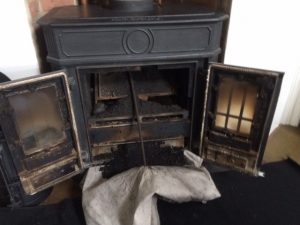I recently swept this Coalbrookdale Severn Multi-Fuel Stove at an address in Wendons Ambo. As can be seen the flue was rather dirty; the material removed from the flue consisted largely of tarry deposits. These type of tarry deposits in a chimney potentially present something of a fire risk, so it was as well that the customer always has an annual sweep of their appliance. Such tarry deposits are usually caused by the customer turning down the stove too much. This deprives the fire of oxygen leading to incomplete combustion of the material in the firebox; which in turn leads to tarry deposits forming in the chimney and polluting emissions emanating out into the atmosphere. This is something that the government have been very concerned about in recent times, and which the customer can easily avoid by taking simple steps to burn their appliance in the correct manner. The answer is to NOT turn the appliance down too much! If there is always sufficient oxygen going into the appliance, then the fire will burn efficiently and there will be full combustion. This will avoid pollution going into the atmosphere and the chimney being coated with unwanted tarry deposits. I always advise my customers to keep an eye on the glass windows in their appliance if they have turned it down. I tell them that if they see tar forming on the glass (usually at the bottom first), then they need to turn the stove up slightly. This is because what the will observe happening on their stove glass presents a microcosm of what is occurring up their chimney, i.e. if the glass is starting to tar up then this will be happening much worse up their chimney. If in doubt customers should take a look at the Guild of Master Sweeps advice to customers and the ‘Burn Right’ campaign:
https://www.guildofmasterchimneysweeps.co.uk/does-my-fire-harm-the-environment/
I do like these old Coalbrookdale Severn stoves, particularly the decorative swans on the air intake controls and the name Severn on the top of the stove. The Coalbrookdale Company also manufactures another similar stove called the Darby which has similar ornate decorative features.
I believe that these Severn stoves are no longer made any more, indeed any of the Coalbrookdale range of stoves. I understand that the Coalbrookdale was at some stage taken over by Aga, who make their own range of wood-burning stoves. As I have said previously, I see a lot of Severn Stoves in and around the Walden area; in particular in Radwinter, Wimbish, Ashdon, Wendons Ambo and Arkesden to name a few. However, in all these instances the stoves have been in place for a long time, 30 years plus in some instances. This leads me to believe that the stove was very popular in the past, and that someone locally was inclined to fit them by preference. One customer recently told me that it was Ridgeons who sold the entire range of Coalbrookdale stoves and that may people locally bought them and either fitted them themselves or had local builders do the work. Clearly this was in the days prior to specialist stove installers and would account for the fact that many of the installations Coalbrookdale stoves I have seen locally are not the best.
What I did find of interest whilst conducting my internet searches, was that the Coalbrookdale Company has an extremely long and interesting history that goes right back to the birth of the Industrial Revolution and far beyond. In the 12th Century the area of Coalbrookdale which is in Shropshire fell within the manor of Madeley, which belonged to Much Wenlock Priory. The monks here operated a bloomery (iron foundary) called “Caldebroke Smithy”. In 1536 bloomery recorded as still being in operation, however in 1540 during the dissolution of the Monistaries Much Wenlock Priory was closed by King Henry VIII, but the bloomery continued working. Then in 1544 the “Smethe Place” and “Calbroke Smethe” were leased to a Hugh Morrall. This is believed to refer to the Lower Forge (SJ667038) and Upper Forge (SJ669042). Before in 1545 the abbey’s lands being eventually bought by the king’s Italian physician, Agostino Agostini but he sold them in the same year (presumably at a profit) to a local man called Thomas Lawley. Then in 1572 the manor was acquired by John Brooke, who constructed a number of coal mines on his land and continued the operation of the bloomery.
In 1615 Brooke’s son, Sir Basil Brooke, bought the patent for making steel by the cementation process and built a blast furnace at Coalbrookdale. Interestingly, Brooke was arrested in 1644 by Parliament after being involved in a plot to prevent the Scottish army taking part in the English Civil War. The following year Brooke’s estate was sequestrated by Parliament but the works continued in use. Then in 1651 the manor was leased to Francis Wolfe, the clerk of the ironworks, by Brooke’s heirs. Brooke had died in 1646 so presumably Parliament had returned the manor to his family. In 1658 – a new blast furnace and forges were built. In 1688 the ironworks were leased by a Shadrach Fox, who in 1696 was supplying round cannon shot and grenado shells to the Board of Ordnance during the Nine Years War. Unfortunately in 1703 the furnace blew up but the forges remained in use.
In 1709 Abraham Darby I acquired the lease and created the Coalbrookdale Company, an iron foundry which used coke as fuel to make pots and pans. The company had a very long history and is famous for making the first iron bridge which still stands to this day. In 1945 the company started manufacturing wood-burning stoves and the Rayburn cooker. In 1969 the company was absorbed into Allied Ironfounders Ltd.



 My name is Paddy McKeown, I am a retired police officer (Detective Sergeant – Metropolitan Police), turned chimney sweep. I have completed training with ‘The Guild of Master Chimney Sweeps’, and Rod Tech UK (Power Sweeping).
My name is Paddy McKeown, I am a retired police officer (Detective Sergeant – Metropolitan Police), turned chimney sweep. I have completed training with ‘The Guild of Master Chimney Sweeps’, and Rod Tech UK (Power Sweeping).




Comments are closed.